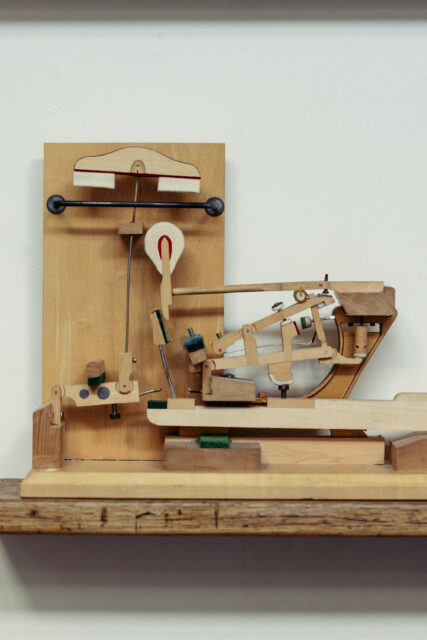Frequently Asked Questions
How much does it cost to tune a piano?
This depends on how out of tune the piano is, how much work needs to be done, and whether any replacement parts need to be ordered. We have several service options, which vary in price depending on the work needed or wanted. Please see the Prices page for more details.
Why should I have my piano tuned every 6 months to one year?
If played regularly, 6 months is around the time that pianos start to ‘sound’ of tune. It could be less time if the piano is played really often, or less if kept in a climate controlled room. We recommend 6 months to one year so we can perform a general checkup of the piano along with the tuning and sort issues out before they become too much of a problem. Think of it like having your car serviced; you can either do it once a year and rarely have any issues, or you can wait years and years and the problems will pile up.
Tuning a piano twice a year is ideal because it allows the piano be kept stable in different seasons. Temperature and humidity vary widely in the UK throughout year and pianos can be hugely affected. Pianos have hundreds of strings that are held in tension by tuning pins. Over time these tuning pins naturally slacken bringing the piano out of tune. Very loud and very frequent playing will also add to this. . Best practice, get the piano tuned regularly for maximum enjoyment of your instrument!
How long does it take to tune a piano?
A standard piano tuning appointment lasts about one hour and includes the tuning of the whole piano, a quick inspection to make sure everything is working correctly, and some small adjustments here and there. If the piano hasn’t been tuned in a long time it will need a 2-hour or 4-hour appointment. This is because the piano will be very out of tune and flat, have a few or many repairs, and will need a pitch raise and a couple of tunings to keep it stable.
What is a pitch raise?
When a piano has not been tuned in many years the pitch of the piano will fall and it will sound really out of tune. This is because the strings are kept under tension by tuning pins, and over time these tuning pins will slacken and the piano becomes flat. Think of a piano string like a metal spring or piece of elastic – when it is stretched it wants to snap back to its previous state before. Luckily the tuning pins of a piano keep the tension strong, but not enough when the change is large. Here we need to stretch the strings sharper than we need so they will fall back to the correct pitch. This is what’s called a pitch raise – essentially raising the pitch of the piano but in a controlled and careful way. The record we’ve seen so far on a piano is a perfect 3rd flat! (please don’t leave it this long, there’s a big risk of strings breaking!)
When it’s been years of a piano drifting flat, suddenly bringing the pitch up in one tuning will not be stable as strings have different tensions throughout the piano. This is why the pitch raises are rough (one, two, or sometimes three passes depending on how bad the piano is) then we do a standard or ‘fine’ piano tuning afterward. Regular piano tuning between 6 months and one year ensures the pitch is kept stable and doesn’t drift flat – something that can get very frustrating when playing along to records or with other musicians.
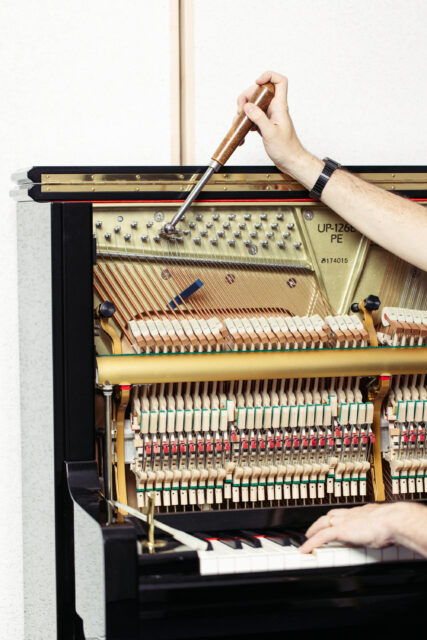
I want to sell my piano. How much is it worth?
How much a piano is worth varies widely depending on its make, age, condition, playability, cosmetic appearance, rarity, restoration value, and many more things. The best advice is to get your piano professionally valued by a piano technician, who can tell you how much your piano will be. Generally speaking, grand pianos are worth more than uprights, newer pianos are worth more than older ones, and certain makes (Steinway, Blüthner, etc.) are worth more than others. We give a detailed report on the condition of your piano in one of our piano assessments and can give an estimated value once the piano has been inspected.
I want to move my piano. Who do I contact?
We have a handful of skilled, reliable movers we use in London who have different prices. Please contact us for more information. In all cases, always use a professional piano mover, especially if there are stairs or tight corners. Pianos are extremely heavy, and many movers do not have insurance for such large and valuable objects such as pianos. Without competent movers, an accident could permenantly damage your piano. Always use a professional mover.
What is a piano action?
The piano action is the removable section of the piano which comprises the hammers, dampers, and other components that transfer the momentum of the pianist’s touch on the keyboard to the strings. This section contains thousands of intricate parts that work together seamlessly. Every part of the action can be adjusted to keep the touch and feel throughout the piano consistent.
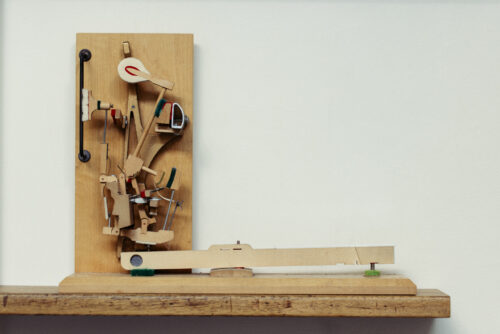
My piano feels sluggish or spongey. Does it need regulation?
Probably yes. Spongey or sluggish pianos are usually due to the components in the keyboard and action not positioned in the correct place. This happens over time because when a piano is played over and over the moving parts start to misalign, felts become compressed, and expansion and contraction of the wooden components cause the piano to be uneven. You may notice the middle section of your piano begin to feel different to the top and bottom ends. This is because most playing is done in the centre of the piano, and this becomes more uneven. When things get really bad, it can get incredibly inconsistent making the piano difficult to play.
Regulation is the art of servicing the keyboard and action so all the components (let off, aftertouch, key dip etc.) are in harmony and positioned correctly, along with lubricating all the action parts – there are many hundreds! A well regulated piano wil be very responsive, and feel fantastic to play. It makes a huge difference to any piano, but particuarly grand pianos. Highly recommended for pianists and music students!
What is voicing?
After a piano has been finely tuned and regulated, we can focus on the tonal quality of the sound. Much of this beautiful, unique sound of the piano comes from the hammers which strike the strings. Try plucking the string of a piano with a guitar pick and compare this to a piano hammer to see the difference in tone. These piano hammers are made from compressed felt and can be manipulated to change the tone of the note. By filing away grooves that appear on the hammers, correctly aligning them to the strings, and then using needles and occasionally lacquer to adjust the brightness, sustain, and tone of the piano; we can unleash the best sound of a piano. This is what is known as voicing or sometimes toning. Voicing can be extremely varied and individual to different brands and ages of pianos. It is an art that takes many years to truly master and is only recommended to be done by skilled piano technicians. The effects of voicing are extremely noticeable and can rejuvenate a piano’s sound, especially finer grand pianos.
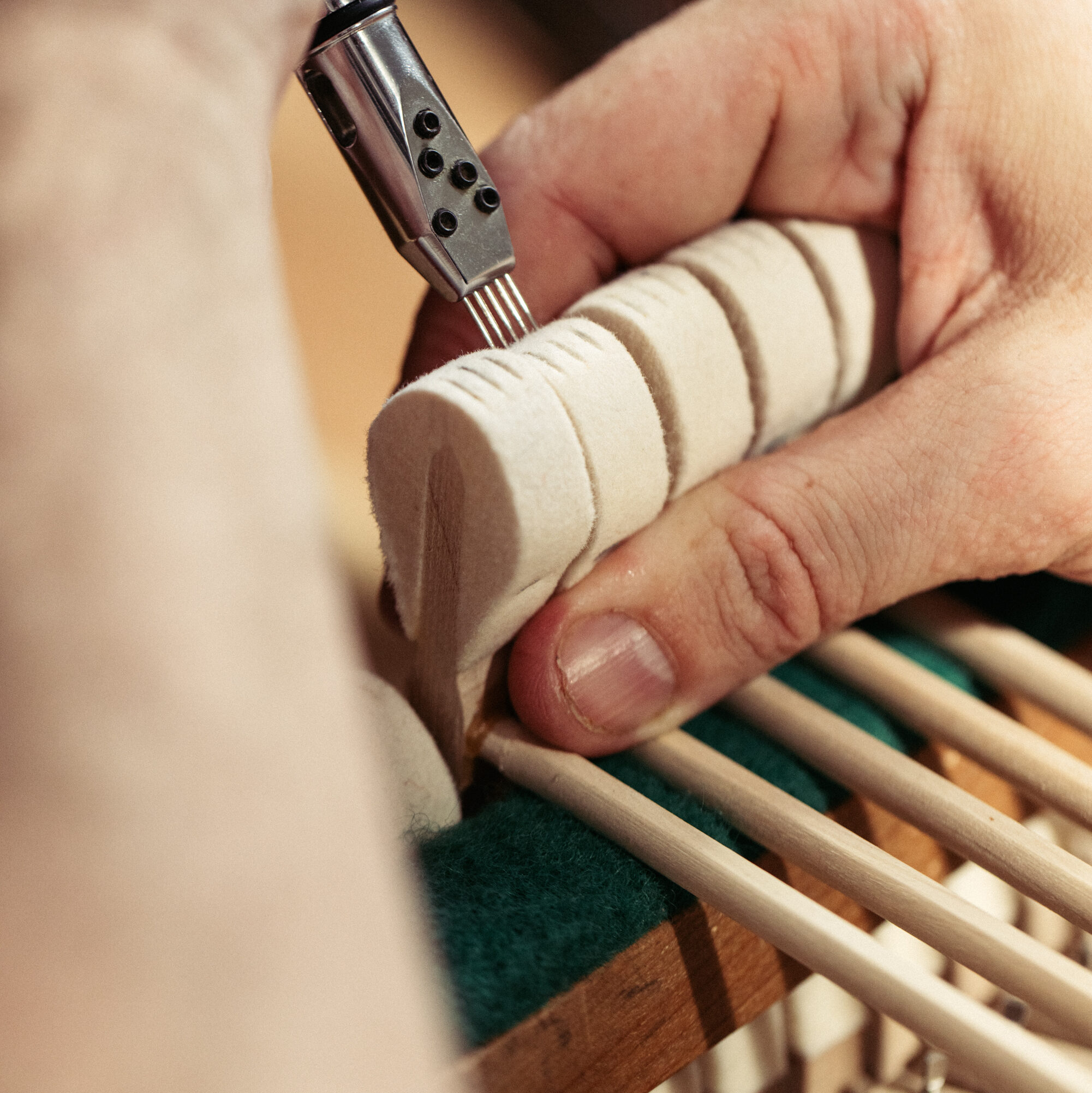
How is a piano valued?
Pianos are expensive instruments, but there is a wide range of price and quality. Brand new they can cost as high as £180000, or as low as £1500. Regardless of price, a piano is similar to a car in its long-term value: A brand-new piano will immediately lose a percentage of its value when it is bought, and then will slowly decrease in value over a period of several decades. Some pianos, particularly fine antique grand pianos and novelty pianos (Elton John or Oscar Peterson’s piano for example) will remain high in value because of their rarity. Many of these older pianos, notably Steinway, are completely refurbished and significantly increase in value. In fact, there are now many piano businesses that solely rebuild older grand pianos and resell them. Unfortunately, the reality is that most pianos, particularly cheaper uprights, will eventually over a period of many decades become worthless. Piano rebuilders will often value a piano like a car: If a car crashes and the repair costs more than the value of the car, then it is written off. Pianos are the same, except the ‘crash’ happens over a long time! This is why the majority of rebuilds are the highest-quality grand piano manufacturers such as Steinway & Sons, Bösendorfer, Blüthner, Bechstein, and Fazioli.
How is a piano tuned?
Tuning a piano is a process that requires much finesse and takes many years to master, and to explain in full is quite lengthy. However, in brief, a piano is tuned by adjusting the pitch of a particular string by turning the tuning pin the string is looped around with a tuning hammer. Piano strings are under a lot of tension so this ‘hammer’ is very strong. Firstly a temperament is set in the middle range of the piano where the tuning is the least difficult. This is followed by tuning the octave and then unisons of notes in the treble and bass. This is a time-consuming process as there are over 200 strings in a piano. Finally, the temperament is checked again, and small adjustments are made to strings that are more out of tune.
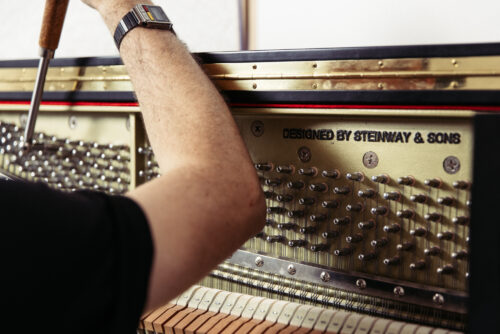
How is a piano rebuilt?
Pianos are manufactured to a high standard, but they do not last forever. The condition of any piano will deteriorate, with corroded strings, worn hammers, dry felts, cracked keys, a cracked soundboard, and very loose tuning pins being several of hundreds of factors that affect pianos over time. This is especially true for pianos that have been exposed to frequent changes in climate and humidity. With some pianos that are more valuable, usually grand pianos, the possibility of rebuilding is present. Rebuilding is literally what it is: taking the piano and rebuilding it from the bottom up. There are different types of rebuilding; often only the strings, tuning pins, and action parts will be replaced. In more extreme cases, and most often with older fine grand pianos (Steinway, Bechstein, etc.) everything but the rim (i.e. the cabinet or case) and the plate will be replaced. This means a new soundboard, a new pinblock, and refinishing the case.
